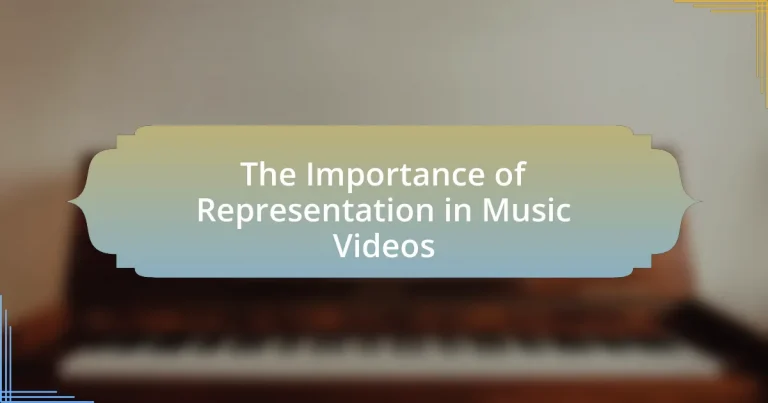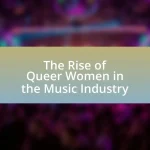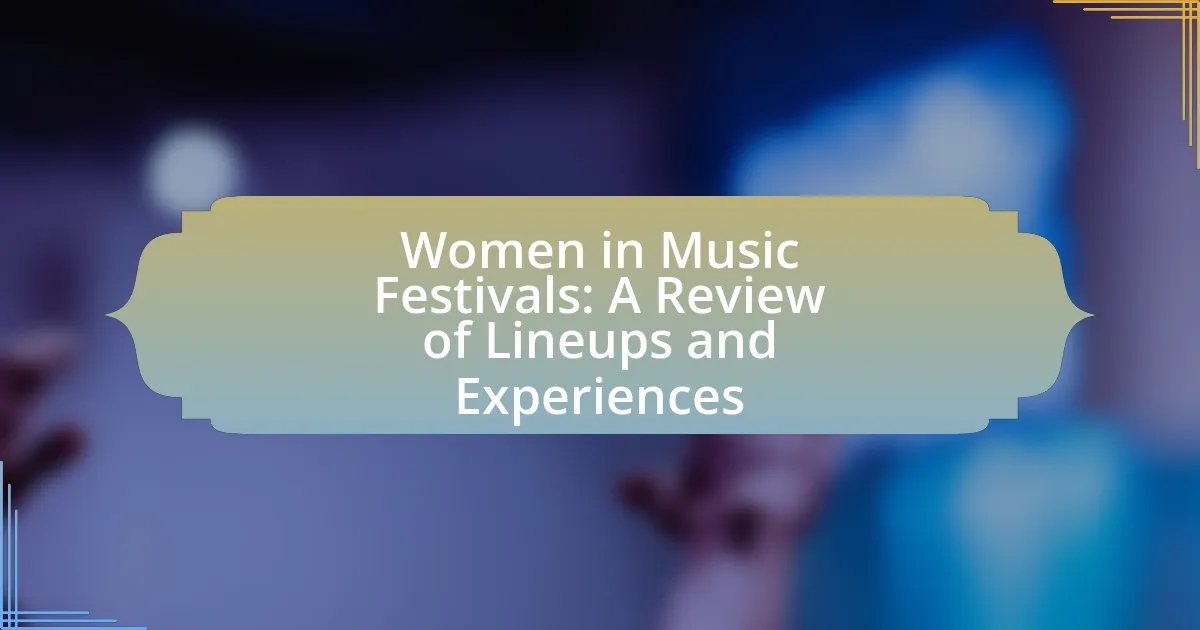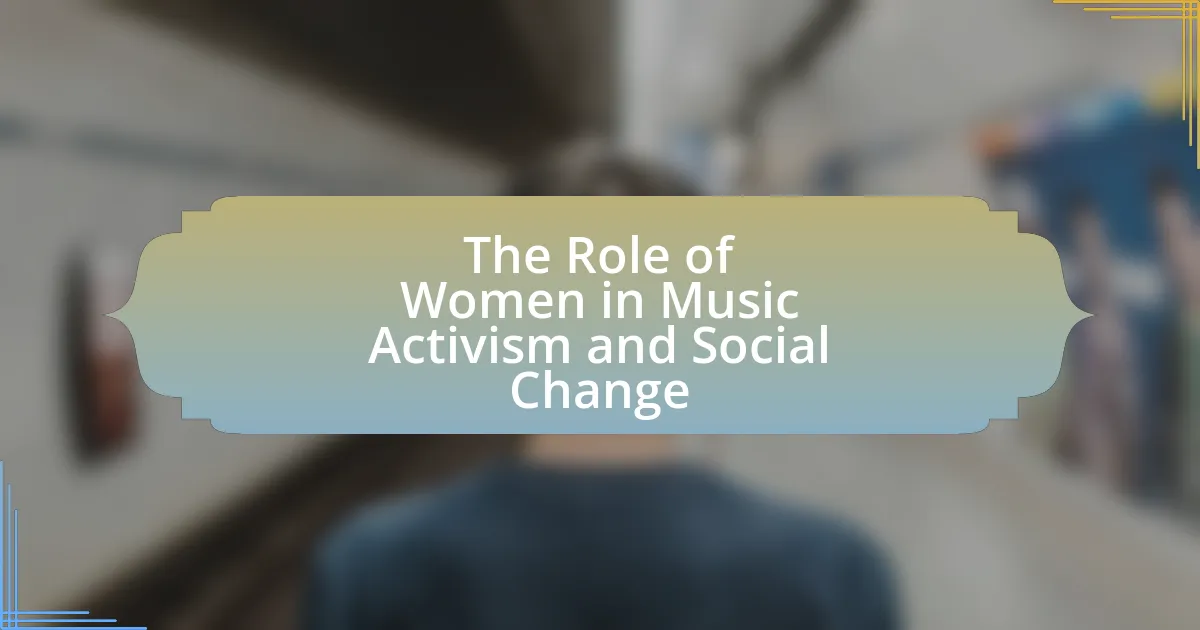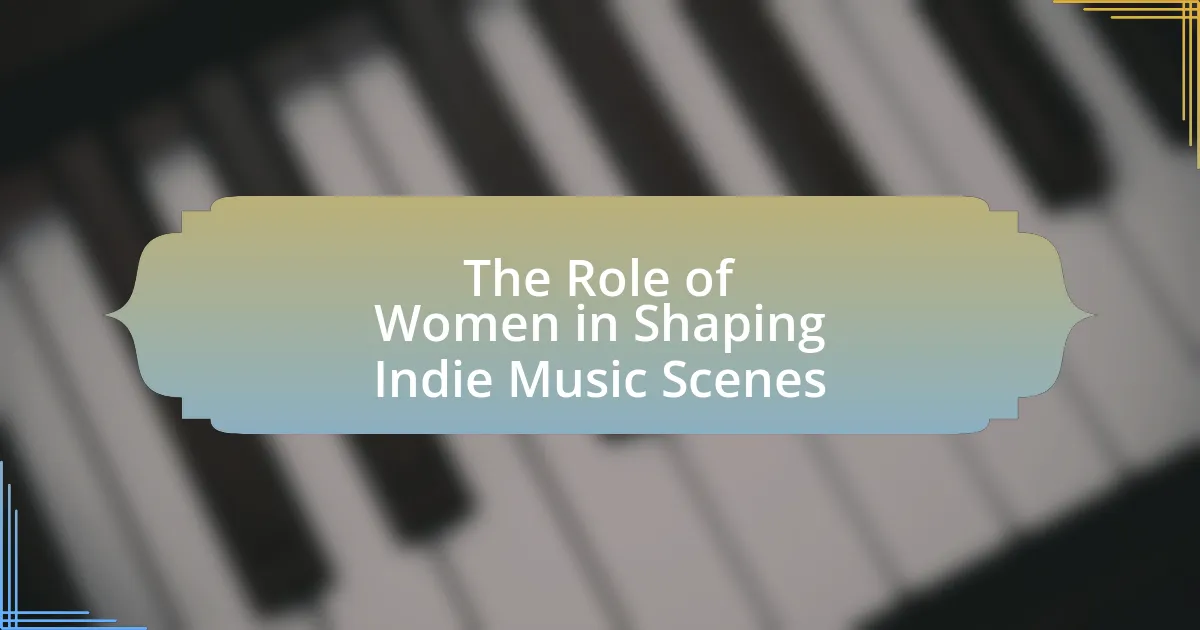Representation in music videos is a critical aspect that shapes cultural narratives and influences societal perceptions. This article explores the significance of representation, highlighting its impact on self-esteem, social acceptance, and the portrayal of diverse identities. It examines how music videos reflect societal values, challenge stereotypes, and promote inclusivity, while also addressing the historical evolution of representation in the medium. Furthermore, the article discusses the role of technology and social media in enhancing representation, as well as practical steps artists can take to improve inclusivity in their work.
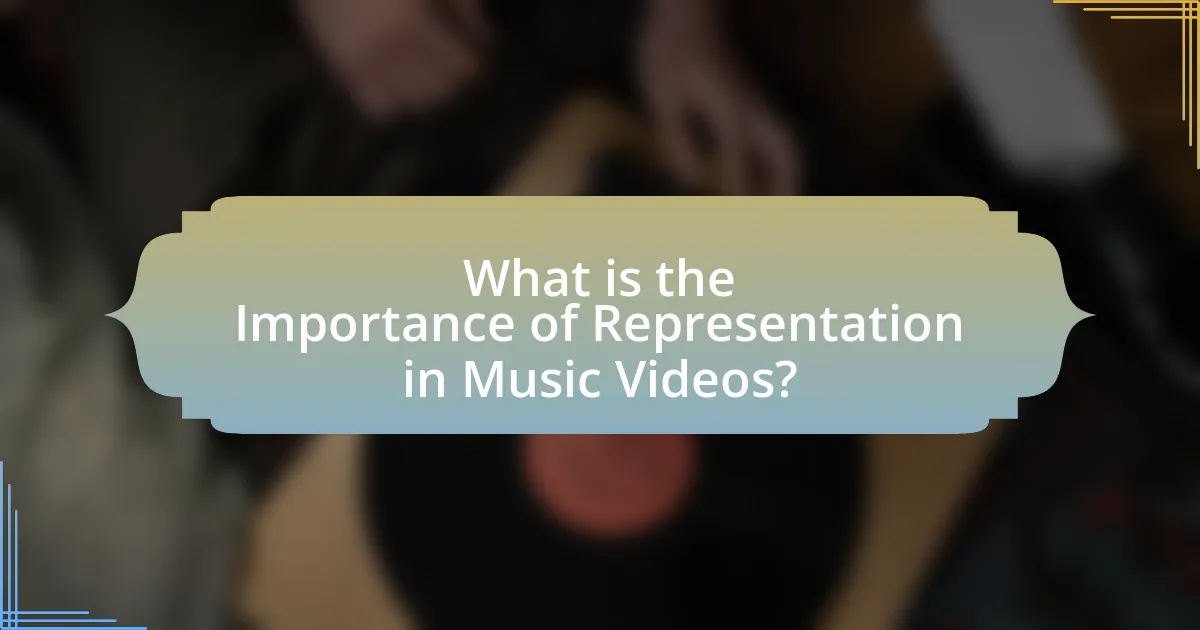
What is the Importance of Representation in Music Videos?
Representation in music videos is crucial as it shapes cultural narratives and influences societal perceptions. Music videos serve as a visual medium that reflects and constructs identities, allowing diverse groups to see themselves represented in mainstream media. For instance, studies show that representation can enhance self-esteem and foster a sense of belonging among underrepresented communities. Furthermore, the portrayal of varied identities in music videos can challenge stereotypes and promote inclusivity, as evidenced by the increasing visibility of LGBTQ+ artists and artists of color in recent years. This shift not only impacts viewers’ understanding of diversity but also encourages the music industry to embrace broader perspectives, ultimately leading to a richer cultural landscape.
Why is representation significant in the context of music videos?
Representation is significant in the context of music videos because it shapes cultural narratives and influences audience perceptions. Music videos serve as a visual medium that reflects societal values, identities, and experiences, allowing diverse groups to see themselves represented. For instance, studies show that representation in media can impact self-esteem and social acceptance, particularly among marginalized communities. According to a report by the Geena Davis Institute on Gender in Media, increased representation of women and people of color in media leads to greater visibility and empowerment, reinforcing the importance of inclusive representation in music videos.
How does representation influence audience perception?
Representation significantly influences audience perception by shaping how individuals relate to and interpret the content presented to them. When diverse identities and experiences are accurately portrayed in music videos, audiences are more likely to feel seen and validated, which can enhance their emotional connection to the music and the artist. Research indicates that representation can alter societal norms and expectations; for instance, a study published in the Journal of Communication found that exposure to diverse representations in media can lead to increased acceptance and understanding of different cultures and lifestyles. This demonstrates that the way artists choose to represent themselves and others in music videos can profoundly impact audience attitudes and beliefs.
What role does cultural identity play in music video representation?
Cultural identity significantly influences music video representation by shaping the themes, visuals, and narratives presented. Music videos often reflect the cultural backgrounds of the artists, which can include elements such as traditional attire, language, and cultural symbols, thereby fostering a sense of belonging and authenticity. For instance, the incorporation of specific cultural motifs can resonate with audiences who share that identity, enhancing emotional connection and relatability. Research indicates that representation in media, including music videos, can impact viewers’ self-perception and cultural pride, as seen in studies highlighting the positive effects of diverse representation on minority groups.
How does representation in music videos reflect societal values?
Representation in music videos reflects societal values by showcasing cultural norms, gender roles, and social issues prevalent in society. For instance, music videos often depict idealized beauty standards and lifestyle choices that resonate with or challenge the audience’s perceptions of identity and belonging. A study by the Geena Davis Institute on Gender in Media found that women are often underrepresented in music videos, which mirrors broader societal gender imbalances and influences public perceptions of women’s roles. Additionally, music videos that address social justice themes, such as racial inequality or LGBTQ+ rights, can serve as a reflection of contemporary societal movements, highlighting the evolving values and priorities of the audience.
In what ways do music videos challenge or reinforce stereotypes?
Music videos challenge stereotypes by presenting diverse narratives and representations that counter traditional norms, while they reinforce stereotypes through the perpetuation of clichéd imagery and roles. For instance, music videos featuring female artists often subvert gender stereotypes by showcasing empowerment and independence, as seen in Beyoncé’s “Run the World (Girls),” which promotes female strength and leadership. Conversely, many hip-hop music videos continue to depict hypermasculine behavior and materialism, reinforcing stereotypes about masculinity and wealth, as evidenced in the frequent portrayal of luxury cars and scantily clad women. This duality illustrates how music videos can simultaneously challenge and reinforce societal stereotypes, shaping public perception and cultural narratives.
How can music videos promote diversity and inclusion?
Music videos can promote diversity and inclusion by showcasing a variety of cultures, identities, and experiences, thereby reflecting the multifaceted nature of society. By featuring artists from diverse backgrounds and incorporating elements such as different languages, traditional attire, and cultural symbols, music videos can challenge stereotypes and foster understanding among viewers. For instance, the music video for “This Is America” by Childish Gambino addresses issues of race and gun violence, highlighting the complexities of American identity. Such representations not only validate the experiences of marginalized groups but also encourage broader audiences to engage with and appreciate diverse perspectives, ultimately contributing to a more inclusive cultural landscape.
What are the historical perspectives on representation in music videos?
Historical perspectives on representation in music videos reveal a significant evolution in how diverse identities are portrayed. Initially, in the 1980s, music videos often reflected mainstream cultural norms, predominantly featuring white, male artists and reinforcing stereotypes. As the genre developed, particularly in the 1990s, artists like Madonna and Michael Jackson began to challenge these norms by incorporating diverse racial and gender representations, which expanded the visibility of marginalized groups.
The rise of hip-hop and R&B in the late 1990s and early 2000s further diversified representation, showcasing artists from various backgrounds and addressing social issues. For instance, videos by artists such as Missy Elliott and OutKast highlighted themes of empowerment and cultural identity.
By the 2010s, the conversation around representation became more pronounced, with movements advocating for inclusivity and authenticity in visual storytelling. Artists like Beyoncé and Lizzo utilized their platforms to address issues of race, body positivity, and gender equality, reflecting a broader societal shift towards recognizing and valuing diverse narratives.
This historical trajectory illustrates how representation in music videos has evolved from a narrow focus to a more inclusive approach, mirroring changes in societal attitudes towards race, gender, and identity.
How has representation evolved over the decades in music videos?
Representation in music videos has evolved significantly from the 1980s to the present, reflecting broader societal changes and increasing diversity. In the 1980s, music videos often featured stereotypical portrayals of race and gender, with limited representation of marginalized groups. By the 1990s, artists like Janet Jackson and Tupac Shakur began to challenge these norms, incorporating themes of empowerment and social justice. The 2000s saw a rise in the visibility of LGBTQ+ artists and narratives, exemplified by videos from artists such as Lady Gaga and Frank Ocean. In recent years, music videos have embraced intersectionality, showcasing a wider array of identities and experiences, as seen in works by artists like Lil Nas X and Beyoncé. This evolution highlights a growing recognition of the importance of authentic representation in media, influencing cultural conversations and promoting inclusivity.
What notable music videos have made significant impacts on representation?
Notable music videos that have made significant impacts on representation include “This Is America” by Childish Gambino, which addresses gun violence and systemic racism in the United States, and “Formation” by Beyoncé, which celebrates Black culture and addresses issues of police brutality. “Born This Way” by Lady Gaga promotes LGBTQ+ acceptance and empowerment, while “Alright” by Kendrick Lamar serves as an anthem for the Black Lives Matter movement, highlighting resilience in the face of oppression. Each of these videos has sparked conversations and raised awareness about critical social issues, demonstrating the power of visual media in shaping cultural narratives.
How does representation in music videos affect artists and their careers?
Representation in music videos significantly impacts artists and their careers by shaping public perception and influencing audience engagement. When artists portray diverse identities and experiences, they can resonate more deeply with a broader audience, leading to increased fan loyalty and marketability. For instance, a study by the University of Southern California’s Annenberg Inclusion Initiative found that music videos featuring diverse casts and themes tend to attract higher viewership and engagement rates, demonstrating that representation can enhance an artist’s visibility and commercial success. Furthermore, artists who embrace authentic representation often gain critical acclaim and support from advocacy groups, which can further elevate their careers in the competitive music industry.
What strategies can artists use to enhance representation in their music videos?
Artists can enhance representation in their music videos by intentionally including diverse cast members, showcasing various cultural backgrounds, and addressing social issues relevant to underrepresented communities. By featuring actors, dancers, and crew from different ethnicities, genders, and abilities, artists can reflect a broader spectrum of society. For instance, Beyoncé’s “Brown Skin Girl” celebrates Black womanhood and features a diverse range of women, which not only promotes visibility but also empowers marginalized groups. Additionally, incorporating narratives that highlight social justice themes can resonate with audiences and foster a sense of inclusion, as seen in Childish Gambino’s “This Is America,” which critiques systemic racism. These strategies not only enhance representation but also contribute to a more inclusive music industry.
How can collaboration with diverse creators improve representation?
Collaboration with diverse creators improves representation by incorporating varied perspectives and experiences into the creative process. This inclusion leads to more authentic and relatable content that resonates with a broader audience. For instance, research by the USC Annenberg Inclusion Initiative found that films with diverse directors and writers are more likely to feature diverse characters, highlighting the impact of diverse voices in storytelling. By working together, creators can challenge stereotypes and promote inclusivity, ultimately enriching the narrative landscape in music videos.
What are the best practices for ensuring authentic representation?
The best practices for ensuring authentic representation in music videos include involving diverse voices in the creative process, accurately portraying cultural elements, and prioritizing representation in casting. Involving individuals from the represented communities ensures that their perspectives and experiences are authentically reflected. Accurately portraying cultural elements, such as clothing, language, and traditions, prevents stereotypes and promotes genuine understanding. Prioritizing representation in casting not only provides opportunities for underrepresented artists but also allows for more relatable and authentic narratives. Research indicates that diverse representation in media can lead to increased audience engagement and positive social change, highlighting the importance of these practices in music videos.
What are the potential consequences of poor representation in music videos?
Poor representation in music videos can lead to harmful stereotypes and reinforce negative societal norms. When marginalized groups are depicted inaccurately or in a limited scope, it perpetuates misconceptions and biases, which can influence public perception and behavior. For instance, studies have shown that media portrayals significantly affect audience attitudes; a report by the Geena Davis Institute on Gender in Media found that women are often underrepresented and depicted in stereotypical roles, which can contribute to gender inequality in society. Additionally, poor representation can alienate audiences, leading to a lack of connection with the content and diminishing the cultural relevance of the music. This disconnection can ultimately affect the commercial success of the artists involved, as audiences may feel unrepresented and disengaged from the music and its message.
How can negative representation impact marginalized communities?
Negative representation can significantly harm marginalized communities by perpetuating stereotypes and reinforcing societal biases. Such portrayals often lead to discrimination, reduced opportunities, and internalized stigma among individuals within these communities. For instance, studies have shown that negative media portrayals can influence public perception, resulting in lower social acceptance and increased prejudice against marginalized groups. Research by the American Psychological Association indicates that consistent exposure to negative stereotypes in media can adversely affect the self-esteem and identity of individuals from these communities, leading to detrimental mental health outcomes.
What backlash have artists faced due to misrepresentation?
Artists have faced significant backlash due to misrepresentation, often resulting in public outrage and damage to their reputations. For instance, when artists portray cultures or identities inaccurately, they can be accused of cultural appropriation, leading to protests and calls for accountability. A notable example is the criticism faced by artists like Katy Perry and Miley Cyrus for their use of cultural symbols in music videos, which many viewed as disrespectful and exploitative. This backlash can manifest in social media campaigns, negative press coverage, and a decline in fan support, illustrating the critical need for accurate representation in music videos.
What are the future trends in representation within music videos?
Future trends in representation within music videos will increasingly focus on diversity and inclusivity, reflecting a broader spectrum of identities and experiences. This shift is driven by audience demand for authentic representation, as seen in the rise of artists from various backgrounds gaining mainstream visibility, such as Lil Nas X and Bad Bunny, who challenge traditional norms. Additionally, advancements in technology, such as augmented reality and virtual reality, will allow for more creative storytelling that highlights underrepresented voices. Research indicates that diverse representation in media can positively influence societal perceptions and acceptance, reinforcing the importance of these trends in music videos.
How is technology influencing representation in music videos?
Technology is significantly influencing representation in music videos by enabling diverse storytelling techniques and enhancing visual effects. The advent of high-definition cameras, drones, and advanced editing software allows creators to depict a wider range of identities and narratives, making music videos more inclusive. For instance, platforms like YouTube and TikTok provide artists with the ability to reach global audiences, showcasing varied cultural backgrounds and perspectives that were previously underrepresented. Additionally, data analytics tools help artists understand audience preferences, leading to more targeted and representative content. This shift is evident in the increasing visibility of LGBTQ+ artists and artists of color, reflecting broader societal changes and demands for representation in media.
What role do social media platforms play in shaping representation?
Social media platforms play a crucial role in shaping representation by providing a space for diverse voices and perspectives to be shared and amplified. These platforms enable artists and creators from various backgrounds to showcase their work, thereby challenging traditional narratives and promoting inclusivity. For instance, research by the Pew Research Center indicates that 69% of adults in the U.S. use social media, which facilitates the rapid dissemination of content that reflects a wide array of cultural identities. This democratization of content creation allows underrepresented groups to gain visibility and influence public perception, ultimately impacting the representation seen in mainstream media, including music videos.
What practical steps can be taken to improve representation in music videos?
To improve representation in music videos, creators should prioritize diverse casting, inclusive storytelling, and collaboration with underrepresented artists. Diverse casting ensures that various ethnicities, genders, and body types are visible, reflecting the audience’s diversity; for instance, a study by the Annenberg Inclusion Initiative found that only 22.5% of music videos featured women, highlighting the need for gender balance. Inclusive storytelling involves creating narratives that resonate with different cultural backgrounds, which can enhance relatability and engagement. Collaborating with underrepresented artists not only amplifies their voices but also brings fresh perspectives to the creative process, as seen in projects like Beyoncé’s “Black Is King,” which celebrated Black culture and artistry. These steps collectively foster a more equitable representation in the music video landscape.
